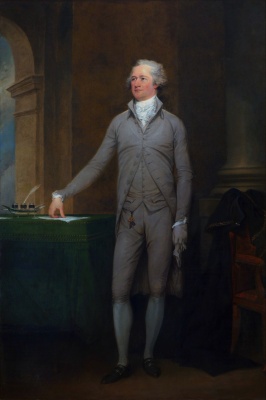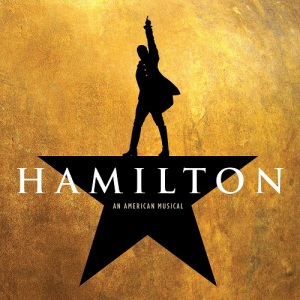
Got a lot farther by working a lot harder, by being a lot smarter. . . Portrait of Alexander Hamilton by John Trumbull, 1792
Please forgive the relative silence on this blog lately, friends. I’ve been busier–in the words of my late, profane grandmother–“than a cat covered in $hit!” Much to my surprise, I’ve found it psychologically more comfortable these days to immerse myself in the eighteenth century rather than so-called “reality” these days. Not that the eighteenth century was a time when things were “great”–far from it! But, the eighteenth century has the virtue of being over and done with for more than two centuries, so I don’t have any responsibility for making it better. That’s its primary virtue for me now.
But look what happens when you listen to the Hamilton: An American Musical soundtrack on your drive and walk to work every day: you (I) wake up with #Hamiltunes on your mind, and you (I) walk around humming “Thomas Jefferson’s coming home. . . “ or “The Room Where It Happens,” and saying out loud to colleagues “sometimes it makes me wonder why I even bring the thunder.” (Oops!) You (I) make irritating allusions to Hamilton, like adding “Sir,” to the ends of sentences, and sign your emails “I have the honor to be your obedient servant, H.Ann.”
 Other historians are doing much better than I am in the creative and fun ways they’re using the Hamilton pop culture phenomenon in their classrooms and in public outreach. Here are some recent examples–and since I plan to play at least one song a day next semester in HIST 341: Eighteenth-century America, the course in which I teach the American Revolution, I am eager to learn of other examples like these, so please add your links and ideas in the comments below:
Other historians are doing much better than I am in the creative and fun ways they’re using the Hamilton pop culture phenomenon in their classrooms and in public outreach. Here are some recent examples–and since I plan to play at least one song a day next semester in HIST 341: Eighteenth-century America, the course in which I teach the American Revolution, I am eager to learn of other examples like these, so please add your links and ideas in the comments below:
- Michelle Orihel of Southern Utah University (and a fellow FREAC) contributed a guest post to The Junto, explaining how she is using Hamilton: An American Musical to get her students to engage with eighteenth-century print culture, especially the Reynolds Pamphlet. She writes, “the song effectively captured my students’ attention and complemented the pamphlet nicely, extending my students’ analysis of that work.” (Check out her previous post at The Junto about using of the Hamilton song “Farmer Refuted”–it’s mentioned in this blog post but they don’t include a link!)
- Karin Wulf quotes Hamilton: An American Musical right in the title of “‘Awesome, Wow’: King George III in the American Popular Imagination,” discussing along the way not just King George in the musical but also in children’s books and in the 1994 film version of Alan Bennett’s outstanding The Madness of King George. She also comments on a #Ham4Ham performance of “The Schyler Georges,” featuring three of the actors who played George III in the off-Broadway and on-Broadway version of the show lip-synching “The Schuyler Sisters.” Wulf writes, “Having Groff appear as the senior sister, the brainy Angelica Schuyler, makes an even more compelling counterpoint for George III than Hamilton himself. Schuyler’s lines invoke revolution beyond the aims of the revolutionaries: “I’ve been reading Common Sense by Thomas Paine/ So men say that I’m intense or I’m insane/ You want a revolution? I want a revelation!” It’s not only a revolution against monarchy, but patriarchy she’s aiming for. Groff’s King George/ Angelica: “So listen to my declaration/ We hold these truths to be self-evident/ That all men are created equal/ And when I meet Thomas Jefferson/ I’m ‘a compel him to include women in the sequel!” This is a King George that American millennials –and maybe their British counterparts, too–can love.” WORK!
- I’m looking forward to talking about the Hamilton phenomenon with my graduate students next week, along with Andrew Schocket’s “Ron Chernow’s Hamilton is Not Throwing Away Its Second Shot” at Process: a blog for American history, the OAH blog. We’ve been talking in class all semester long about more or less effective ways that historians can engage the public with their research and ideas. I’m also looking forward to reading and discussing Schocket’s recent book, Fighting over the Founders: How We Remember the American Revolution (2015) with my HIST 341 students next term. You can see Andy’s blog here, if you want to learn more.
- ICYMI, my grad class next week is also going to review and discuss “#hamildays: A Hamilton –Inspired Journey through the Stacks” of the American Antiquarian Society, which was itself inspired by the Instagram account of project cataloger Amy Tims (aka rarebkcat) in which she found and photographed one or more items in the AAS collections to correspond with every song in the Hamilton cast album and posted them under the #Hamildays hashtag. This is a very well-done experiment in the use of social media by a historical institution to engage a different and perhaps wider public than their usual clientele, and to make links between its collections and contemporary pop culture.
Other links to the #HamilCraze that seems to have overtaken some of us lately? (Or, to quote Daveed Diggs’s Thomas Jefferson, “Whatd’I miss?” Let me know what you think!
I’m co-teaching a course on Hamilton (“Hamilton: Bullets, Banks, and Broadway”) next quarter, and gathered a lot of resources at http://www.culjp.com/blog/joanna-grisinger-hamilton-in-the-classroom. Lyra Monteiro’s award-winning essay “Review Essay: Race-Conscious Casting and the Erasure of the Black Past in Lin-Manuel Miranda’s Hamilton”(http://tph.ucpress.edu/content/38/1/89) deserves its own shout-out.
LikeLiked by 1 person
Thanks, Joanna, for sharing! Yes, I forgot to note Lyra Monteiro’s essay, which I saw last spring. Great addition.
LikeLike
If I were teaching, these would be fabulous ideas. Instead, Hamilton was the soundtrack for my Thanksgiving cooking–and it had me thinking about the past, present, and future while I chopped and sautéed.
LikeLiked by 1 person
You decided the menu, the venue, the seating?
We also had the Hamiltunes going while completing Thanksgiving dinner! Hamilton is pretty big among the middle-school theater geeks around here.
LikeLiked by 1 person
Family dinner was here with our traditional menu. 🙂
I’m sure Hamilton is big with middle and high school theater geeks here, too.
LikeLiked by 1 person
I haven’t even listened to it yet, but I put it on the syllabus for my general humanities course next semester. I bought the LP box set at Thanksgiving – ridiculously expensive, but I wanted it on vinyl – and some evening soon I am going to settle in and listen to it. Or maybe after finals. Glad to see so many good ideas about how to use it.
LikeLiked by 1 person
Nursing Clio posted on Hamilton too–one discussing the show as a model for women’s history:
https://nursingclio.org/2016/05/24/back-in-the-narrative-hamilton-as-a-model-for-womens-history/
and a second post on the Hamilton Documentary that aired on PBS this fall:
https://nursingclio.org/2016/10/27/i-know-this-guy-humanity-in-hamiltons-america/
LikeLike
I wrote about my introduction to Hamilton back in October. here
After a successful short lecture on Hamilton in my Humanities class, I decided to teach it in my modern drama survey next semester. When I announced that in my Humanities class, nine non-English majors signed up. Nice, eh? I’m going to talk about how Hamilton fits into or reacts to the American dramatic tradition. I have some ideas about that, and I’d like to write about it if I can find time.
LikeLike
I used Hamilton when I began my seminar on Early Medieval histories. I sympathized with the students feeling a bit remote from people who were writing 1400 or so years ago. How distant it seems, and even more so when they’re often writing about people who lived some generations earlier. How random, it sometimes seemed, whose stories survived and whose didn’t? Why, “Who lives, who dies, who tells your story?” I asked.
They mostly didn’t get that, not being trufans, but I turned to Lin-Manuel Miranda’s poetry rap to see if that would help them. We watched that. His passionate evocation of Hamilton’s origins, his performance of Burr’s piece really hit home. I told them that this was an excellent example of the power of history to remake the past while it evoked the same. These medieval people in their histories stand at a far remove to us, but remember: they’re all people, they all have stories and we’re lucky enough to have the chance to try to rediscover and remake them. And maybe, if you want to, even set that interpretation to music! (So far, no takers, though I have a group that’s pitching a TV event based on Charlemagne!)
LikeLike
Charlemagne FTW!!!
I do have one major reservation about Hamilton, though: it doesn’t pass the Bechdel test, as I have written here before. I love it, but I have to say: at the beginning of “The Election of 1800,” when Daveed Diggs says, “Can we get back to politics,” I say “please!” along with the rest of the men. . .
I just don’t grok the women in this musical, and as you all know, I’m all about the women.
LikeLike
I just downloaded the album, so that I can listen to it. . . not sure when, because everyone makes it seem as if I have to pay attention. But I might start playing songs in the car instead of listening to the radio…
LikeLiked by 1 person
Reblogged this on Acta Historia- The Global Journal.
LikeLike
This is great! Always a delight Dr. Little!
LikeLike
I was even able to work Hamilton into a Soviet history class last spring, describing Stalin in the early 1920s as “the guy who’s gonna wait for it” (in the jockeying for supremacy after Lenin’s death). This was just an ad-libbed aside in a lecture, but it got my musical geek students smiling. Definitely great music to cook to!
LikeLiked by 1 person
These are great ideas & links, H.Ann! Since I’m not an early Americanist, I have to work out my Hamilton obsession through other means, mostly through blog posts that talk about how later 19th- and 20th-century readers saw A.Ham and A. Burr.
LikeLiked by 1 person
Great points, Historiann. I’m “all about the women,” too. Two ideas for a U.S. History survey course, with “Hamilton” tie-ins: 1) AH’s “Report on Manufactures” with its casual suggestion that manufacturing could be carried on by “persons who would otherwise be idle,” i.e., farmers’ daughters and wives. More interesting implications to explore, perhaps, than those surrounding “assumption of state debts.” 2) Eliza Schuyler Hamilton lived until around 1850 and she didn’t spend all her time burnishing his reputation or applying for her pension from Congress. She was heavily involved in running a post-Revolutionary women’s organization, an orphanage founded in NYC in 1806.
LikeLike